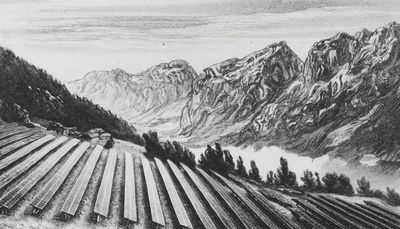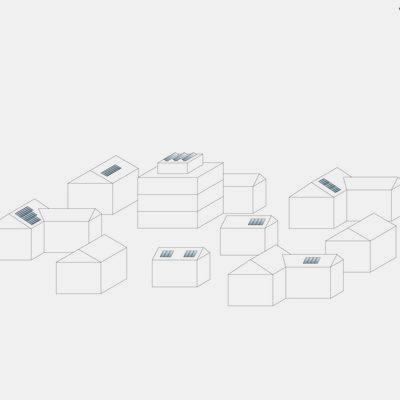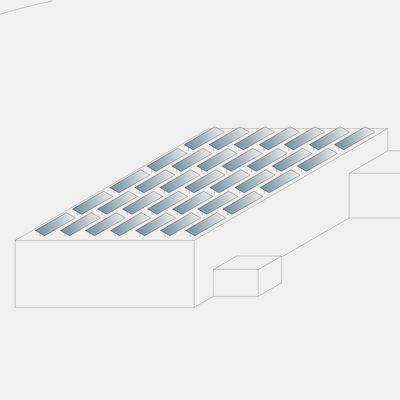AtlasSolar and EKZDavid Bodor, Arno Amez-Droz, and Silas Zeller
Switzerland has been experiencing an impressive solar power expansion over the last decade. However, domestically harvested solar energy still only covers around 6 % of our total electricity demand.
A Sunny Outlook: The Solar Development of Switzerland
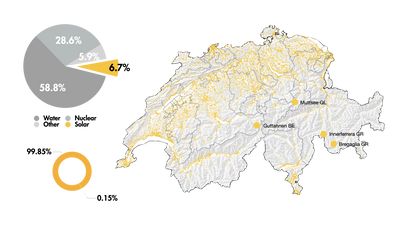
STATUS QUO (YEAR)
Currently the total energy produced in Switzerland by Solar Installations makes up about seven percent of the total electricity produced. As you can see here less than one percent (0.15) of that is produced by solar parks. The biggest one being Muttsee wich produced 3.3 Gigawatt hours per year. As comparison Beznau 1 and 2 produce about 6000 Gigawatt hours per year. The rest is produced by smaller installations mostly on roofs in urban areas.
Solar energy production experienced the largest growth out of any sustainable energy productions in Switzerland in the last ten years. And it doesn’t look like its stopping: in 2022 about 60 % more photovoltaic modules were installed than in 2021. The biggest reason for that are multiple policies that have been implemented by the government to push solar. Explicitly the “Solarexpress” and the “Mantelerlass,” making it easier and more lucrative for homeowners and commercial entities to make solar installations profitable.

COMING SOON (YEAR)
The solar Express is the name of a change in the swiss energy act from 2022. The goal of these changes was to provide urgent measures for the short-term provision of a secure power supply in winter. It was a reaction to the energy crisis in 2022.
This electricity should come from the alpine areas where solar parks would be much more efficient, especially in winter. Two main things it did was simplify the approval procedure and a payment of about 60 % of the investment costs of these projects, if they where at least partially running by 2025.
Scenarios for Solar-Powered Switzerland
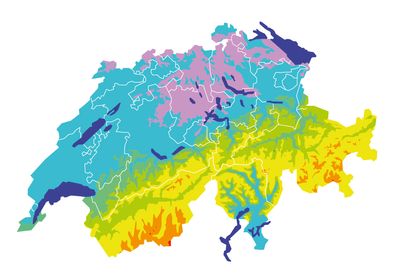
Average annual solar radiation in Switzerland by region.
- below 1100 kWh/m²
- 1101–1200 kWh/m²
- 1201–1300 kWh/m²
- 1301–1400 kWh/m²
- 1401–1500 kWh/m²
- 1501–1600 kWh/m²
- above 1600 kWh/m²
The Alps as a Solar Powerhouse
Solar parks are most effective in the Alps because they can also produce a lot of electricity in winter – Solar Express (parliamentary bill 2022) should massively accelerate the production of Alpine solar plants. Solar plants will receive strong financial support until the end of 2025.
In urban areas, roofs facing south with an inclination of 30-40 degrees are best suited for production in summer and facades (vertical) for winter. These private systems have increased significantly
Current Routes—Illuminating the Electricity Infrastructure
Although solar energy is produced in many at once, there are still some bottlenecks in the current system. Starting from a solar park, a series of long cables supported by huge pylons bring the electricity to the nearest transformer station. From here it flows to your local electricity provider, where it is distributed throughout the village. Some of these houses have private solar panels on the roof. A a portion of the produced electricity is consumed locally by the household and the surplus is sent back to the electricity provider for a small financial return.
Solar Styles and Implementations
The two most common types of solar plants can be categorised as ground-mounted installations and roof-mounted installations. Ground-mounted installations are usually large-scale solar plants that are meant to produce electricity for commercial purposes, such as the solar parks in the Alps. Roof-mounted installations mostly produce electricity for local use, and these are installed on a small scale on residential buildings and as larger scale power plants on industrial buildings.
The advantages of solar parks are above all, their efficiency from both an electricity production and a financial standpoint. They achieve this higher efficiency by being located above the cloud line and getting more solar energy than the modules down in the valley thanks to less weather and atmospheric factors. The cost per cell is also cheaper here because of the mass installation process.
However, these solar parks can lead to environmental impacts and a loss of biodiversity in the affected areas. Some people also highlight the irony of us transitioning to clean energy sources to protect our nature by in turn covering the nature with solar panels. And lastly, the visual impact that these solar parks have on our beautiful Swiss landscapes is simply too much to bear for the majority of the local population.
Roof-mounted installations on the other hand do not harm the environment, because they are built on already existing infrastructure. And speaking of infrastructure, they do not strain the electricity grid nearly as much as solar parks, because a big portion of the electricity gets used up locally. But possibly the biggest advantage of all is the ability of a household to be truly energy independent with the help of solar power combined with the right lifestyle.
Challenges of the Swiss Solar Expansion
Low Percentage of Home Ownership
In 2021, the Swiss house ownership rate was at 36.3 %, meaning that a staggering two thirds of the population were excluded from making decisions about solar solutions for their homes. They have no incentive to install a solar plant on their house anyway, because spending so much on a property that they do not own simply does not make sense financially. On the other hand, the owners of these rented properties are not able to directly profit from and enjoy the benefits of clean, locally produced electricity, so they do not have any incentives to make a change either.
Disagreements in Multy-Family Houses
Around a third of all apartments in Switzerland are located in large apartment buildings with at least seven apartments. These each share a roof, and it is almost impossible for all owners with different mindsets and financial situations to agree on a uniform solution. The chance of these roofs getting covered with solar panels is slim to none.
“Wasted” Roof Space due to lacking Financing
Many homeowners do not want to have the entire roof surface covered. This means that the remaining roof area is “lost”, as the scaffolding is obviously not going to get erected again for a few additional panels at a later date. The reason for this is the high upfront costs, which they do not want to spend on something from which they may not be able to consume the entire amount of electricity produced themselves.
ZEV and the Distribution of Infrastructure
The solution to this sporadic roof coverage would be a so-called ZEV (short for Zusammenschluss zum Eigenverbrauch). This contractual framework describes the linkage of several households in the same jurisdiction to create a smaller shared section within the local electricity grid. Right now these houses must be physically linked with an additional connection, however the Mantelerlass will make it possible to use electricity from anybody’s solar panels within their Gemeinde by simply using the local grid (LEG).
